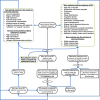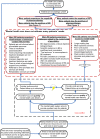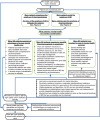Systemic challenges in bipolar disorder management: A patient-centered approach
- PMID: 28901625
- PMCID: PMC5763323
- DOI: 10.1111/bdi.12547
Systemic challenges in bipolar disorder management: A patient-centered approach
Abstract
Objectives: As part of a series of Patient-Centered Outcomes Research Institute-funded large-scale retrospective observational studies on bipolar disorder (BD) treatments and outcomes, we sought the input of patients with BD and their family members to develop research questions. We aimed to identify systemic root causes of patient-reported challenges with BD management in order to guide subsequent studies and initiatives.
Methods: Three focus groups were conducted where patients and their family members (total n = 34) formulated questions around the central theme, "What do you wish you had known in advance or over the course of treatment for BD?" In an affinity mapping exercise, participants clustered their questions and ranked the resulting categories by importance. The research team and members of our patient partner advisory council further rated the questions by expected impact on patients. Using a Theory of Constraints systems thinking approach, several causal models of BD management challenges and their potential solution were developed with patients using the focus group data.
Results: A total of 369 research questions were mapped to 33 categories revealing 10 broad themes. The top priorities for patient stakeholders involved pharmacotherapy and treatment alternatives. Analysis of causal relationships underlying 47 patient concerns revealed two core conflicts: for patients, whether or not to take pharmacotherapy, and for mental health services, the dilemma of care quality vs quantity.
Conclusions: To alleviate the core conflicts identified, BD management requires a coordinated multidisciplinary approach including: improved access to mental health services, objective diagnostics, sufficient provider visit time, evidence-based individualized treatment, and psychosocial support.
Keywords: Theory of Constraints; bipolar disorder; operational excellence; patient priorities; patient-centered; systems thinking.
© 2017 The Authors. Bipolar Disorders Published by John Wiley & Sons Ltd.
Figures




References
-
- Robinson LJ, Thompson JM, Gallagher P, et al. A meta‐analysis of cognitive deficits in euthymic patients with bipolar disorder. J Affect Disord. 2006;93:105‐115. - PubMed
-
- Van Rheenen TE, Rossell SL. Objective and subjective psychosocial functioning in bipolar disorder: an investigation of the relative importance of neurocognition, social cognition and emotion regulation. J Affect Disord. 2014;162:134‐141. - PubMed
-
- Lewis L, Hoofnagle L. Patient perspectives on provider competence: a view from the depression and bipolar support alliance. Adm Policy Ment Health. 2005;32:497‐503. - PubMed
-
- Michalak EE, Yatham LN, Kolesar S, Lam RW. Bipolar disorder and quality of life: a patient‐centered perspective. Qual Life Res. 2006;15:25‐37. - PubMed
Publication types
MeSH terms
LinkOut - more resources
Full Text Sources
Other Literature Sources
Medical
Research Materials

